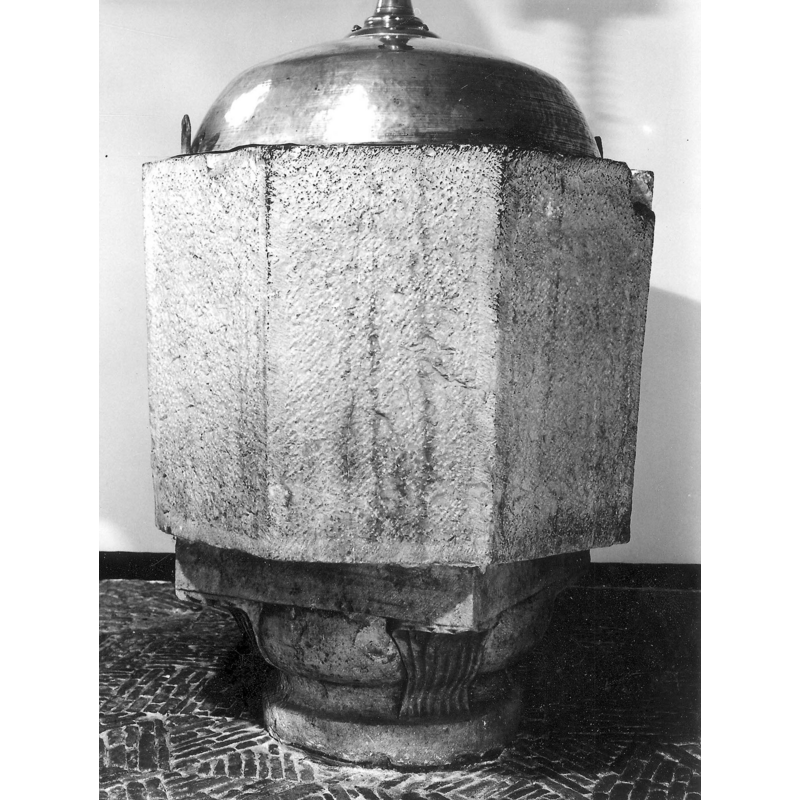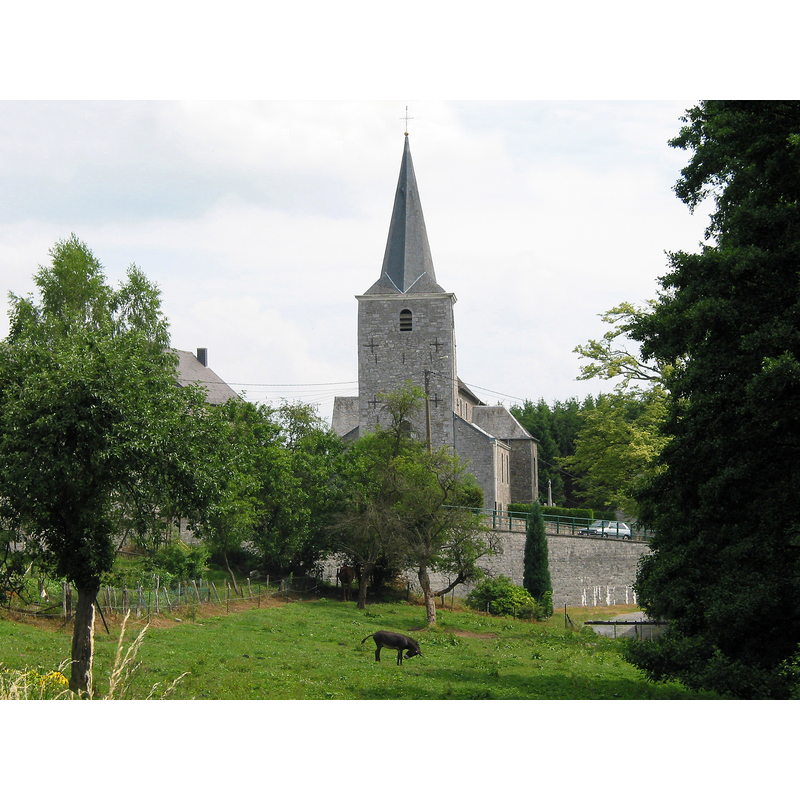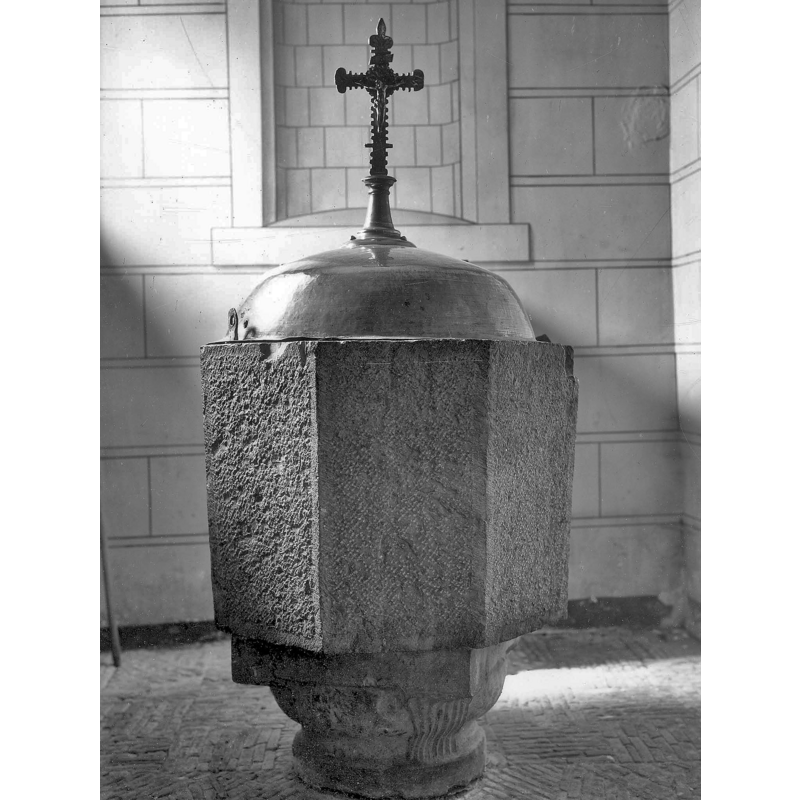Hamois / Halmata / Hamay / Hamwe / Hamwè

Image copyright © KIK-IRPA, Brussels (Belgium), 2022
Reproduced in accordance with KIK-IRPA guidelines
Results: 5 records
design element - motifs - moulding - parallel
Copyright Statement: Image copyright © KIK-IRPA, Brussels (Belgium), 2022
Image Source: digital image of a 1974 B&W photograph [cliché B043770] by Jean Antoine/IRPA [http://balat.kikirpa.be/photo.php?objnr=100195748] [accessed 18 May 2022]
Copyright Instructions: Reproduced in accordance with KIK-IRPA guidelines
view of base
Scene Description: showing the base as it was originally meant to be [cf. FontNotes]
Copyright Statement: Image copyright © Jean-Claude Ghislain, 1971
Image Source: digital image of a B&W photograph by Jean-Claude Ghislain in L'art roman en Belgique by comte J. de Borchgrave d'Altena (pl. VII, fig. a et b), published in les Annales du congrès de la fédération archéologique et historique de Belgique, 41e session; Congrès de Malines II, Malines, 1971
Copyright Instructions: PERMISSION NOT AVAILABLE -- IMAGE NOT FOR PUBLIC USE
view of church exterior in context - west view
Scene Description: Source caption: "Hamois (Belgique), l’église Saint-Pierre."
Copyright Statement: Image copyright © Jean-Pol Grandmont, 2005
Image Source: digital photograph 3 July 2005 by Jean-Pol Grandmont [https://commons.wikimedia.org/wiki/File:0_Hamois_Église_Saint-Pierre_2.JPG] [accessed 18 May 2022]
Copyright Instructions: GFDL / CC-BY-SA-3.0
view of font and cover
Copyright Statement: Image copyright © KIK-IRPA, Brussels (Belgium), 2022
Image Source: digital image of a 1943 B&W photograph [cliché B043819] by the Commissariat général à la Restauration du Pays [http://balat.kikirpa.be/photo.php?objnr=10019574] [accessed 18 May 2022]
Copyright Instructions: Reproduced in accordance with KIK-IRPA guidelines
view of font and cover
Copyright Statement: Image copyright © KIK-IRPA, Brussels (Belgium), 2022
Image Source: digital image of a 1974 B&W photograph [cliché B043770] by Jean Antoine/IRPA [http://balat.kikirpa.be/photo.php?objnr=100195748] [accessed 18 May 2022]
Copyright Instructions: Reproduced in accordance with KIK-IRPA guidelines
INFORMATION
FontID: 23967HAM
Object Type: Baptismal Font1
Church/Chapel: Eglise paroissiale Saint-Pierre / Eglîje Sint-Pîre.
Church Location: rue Saint-Pierre, 5361 Hamois, Namur Belgium
Country Name: Belgium
Location: Namur, Wallonie / Wallonne
Directions to Site: Located off local road N97 [aka Chausée de Liège], N of the N4, about 25 km ESE of Namur
Historical Region: Principauté de Liège
Font Location in Church: Inside the church, in its chapel
Century and Period: 16th century[basin only] [composite font], Late Medieval [composite]
Credit and Acknowledgements: We are grateful to Pol Herman for bringing this font to our attention and for his help in documenting it
Church Notes: earlier church that had a Romanesque tower was re-built 1768
Font Notes:
Click to view
Noted and illustrated in BALaT KIK-IRPA [http://balat.kikirpa.be/object/10019574] [accessed 18 May 2022] as a baptismal font of stone consisting of a plain octagonal basin raised on a squat moulded pedestal base; date given 1501-1600. The font cover is made of metal [brass?], a low dome with a Latin cross finial.
A communication from Pol Herman to BSI (e-mail of 11 May 2022) informs: "The composite octagonal baptismal font of the église Saint-Pierre of Hamois is peculiar because its basin is standing on a base of a Romanesque column, installed upside down. According to Jean-Claude Ghislain, this is not a re-used base of a Romanesque font, but a recycled base of a church pillar. The present building has been constructed between 1761 and 1763, but the old Romanesque church tower has been preserved." Pol Herman (ibid.) further notes: "This font is mentioned in the article L'art roman en Belgique by comte J. de Borchgrave d'Altena (pl. VII, fig. a et b), published in les Annales du congrès de la fédération archéologique et historique de Belgique, 41e session; Congrès de Malines II, Malines, 1971. The pictures in that article were made by Jean-Claude Ghislain [...] The undecorated limestone basin is said to be 16th century. The lid 17th century."
A further communication by Pol Herman (e-mail of 12 January 2024) adds: "By its size, and by its design, the octagonal basin of the baptismal font of Hamois is very unusual for a Belgian church. KIK-IRPA dates it in the 16th century, but I tend to agree with Jean-Claude Ghislain that it is very difficult to put a date on it. It style does not fit any defined filiation. However the support is interesting. It is a Romanesque Mosan limestone base of a column or of a baptismal font, installed upside down, probably 12th century. References :
- Annales du congrès de la fédération archéologique et historique de Belgique, 41e session; Congrès de Malines II, Malines, 1971.
- J. de Borchgrave d'Altena, L'art roman en Belgique, pl. VII, fig. a et b.
De GAIFFIER A., Note sur quelques fonts baptismaux anciens de la Province de Namur, dans Annales de la Société Archéologique » de Namur, 13, 1875, pp. 241-257: "Taillée dans deux blocs de granit la cuve baptismale de Hamois offre l'image d'une table à huit pans, dans laquelle s'excave une vasque profonde et que supporte un pédicule cylindrique très-court. Quatre palmes cantonnant ce dernier membre font l'office de consoles et ménagent ainsi le passage à la forme circulaire au plan octogonal de la table. Enfin en manière d'embasement une moulure en listel vient circonscrire l'assise inférieure du pédicule. La maigreur excessive de ce socle, nullement à l'échelle de la cuve, dont le débord le masque complètement, nous induit à croire que telle n'a pas dû être la composition originelle de ce meuble. L'hypothèse d'une suppression de l'ordonnance d'embasement que nous émettons, afin d'expliquer un disparate de structure si peu compatible avec les principes du moyen-âge, se trouve singulièrement corroborée par cette circonstance : la délicatesse de contours des feuillages du pédicule. Pourquoi en effet, nous sommes nous demandés, le sculpteur eut-il mis tant de soin à profiler un membre qui devait échapper aux regards, alors qu'il se contentait d'épanneler et de ravaler ensuite les surfaces les mieux en vue, les pans coupés de la cuve! A moins donc de taxer de grossière inconséquence l'ordonnateur de cette œuvre, il nous faut bien admettre l'étrange mutilation qu'elle a subie. Reconstitué de la sorte les fonts de Hamois étaient de dimensions extraordinaires; leur grande antiquité, mérite seule, aujourd'hui, de fixer l'attention de l'archéologue."
COORDINATES
Church Latitude & Longitude Decimal: 50.3333333, 5.15
MEDIUM AND MEASUREMENTS
Material: stone, limestone?
Font Shape: octagonal (mounted)
Basin Interior Shape: round
Basin Exterior Shape: octagonal
Font Height (less Plinth): 96 cm*
Notes on Measurements: * BALaT KIK-IRPA
LID INFORMATION
Date: 17th century?
Material: metal, brass?
Apparatus: no
Notes: [cf. FontNotes]
![showing the base as it was originally meant to be [cf. FontNotes]](/static-50478a99ec6f36a15d6234548c59f63da52304e5/others/permission_not_available.jpg)

